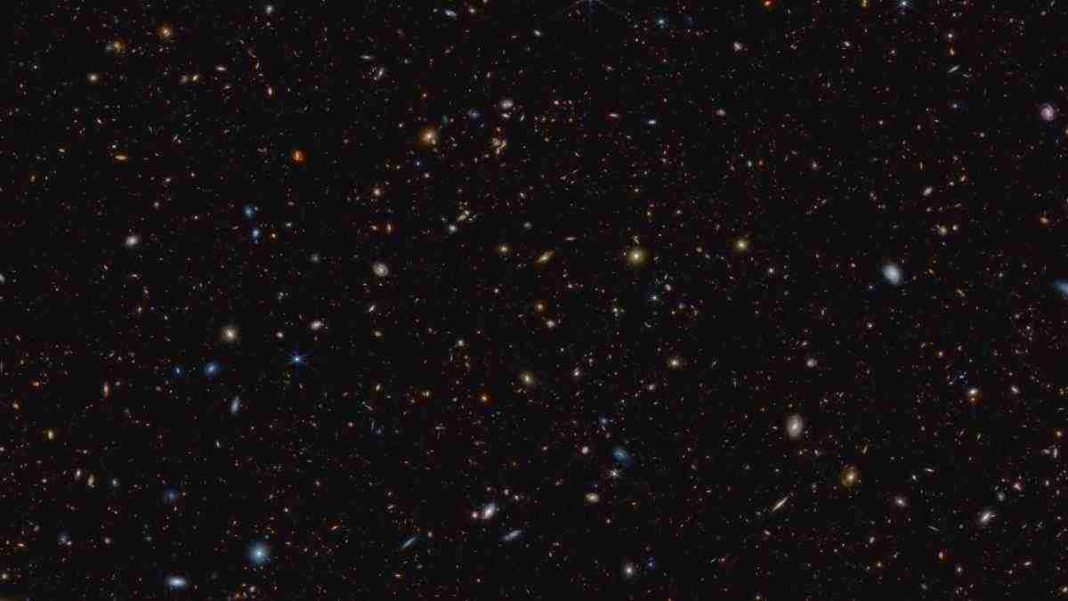UNITED STATES: In what can only be described as a monumental achievement, NASA’s James Webb Space Telescope (JWST) has captured an awe-inspiring image as part of the JWST Advanced Deep Extragalactic Survey (JADES) program. This unprecedented image reveals a mind-boggling sight: a single frame of the sky containing over 45,000 galaxies.
The infrared image, taken as part of the JADES program, provides an extraordinary glimpse into a portion of the sky known as GOODS-South. This region, which has been previously observed by the Hubble telescope, is now showcased in unparalleled detail thanks to the cutting-edge capabilities of the James Webb Space Telescope.
This state-of-the-art observatory, the most powerful of its kind, has astounded scientists and astronomy enthusiasts alike with its ability to peer into the depths of our universe.
The JADES program, dedicated to uncovering and characterizing faint and distant galaxies, has allocated an impressive 32 days of precious telescope time for this ambitious endeavour.
By devoting such a substantial duration to observing these galaxies, astronomers hope to unravel the mysteries surrounding the formation of the first stars and galaxies.
Professor Marcia Rieke from the University of Arizona, a key member of the JADES program, expressed their excitement, saying, “With JADES, we want to answer a lot of questions, like: How did the earliest galaxies assemble themselves? How fast did they form stars? Why do some galaxies stop forming stars?” The core of humanity’s endeavour to comprehend the beginnings and development of our cosmos lies in these fundamental questions.
The galaxies that have come under scrutiny in the JADES program existed between 500 and 850 million years after the Big Bang, a time when the universe was still in its infancy.
During this period, a thick gaseous fog shrouded the cosmos, rendering it opaque to energetic light. However, approximately one billion years after the cataclysmic event that gave birth to our universe, this fog gradually dissipated, allowing light to traverse the vast expanse.
Armed with the Webb telescope’s Near-Infrared Spectrograph (NIRSpec) instrument, astronomers delved into this early epoch of the universe. The results of their investigation were astonishing. The team discovered that the early galaxies were teeming with signs of intense recent star formation.
Each galaxy exhibited remarkably strong emission line signatures, indicative of the presence of hot, massive stars. The earliest galaxies were evidently proficient at producing such stellar powerhouses.
Moreover, the scientists unearthed a fascinating pattern within these ancient celestial bodies. The early galaxies underwent cycles of rapid star formation, punctuated by quieter periods where the formation of new stars slowed down. This observation sheds light on the dynamic nature of the universe during its nascent stages.
Dr Ryan Endsley, leading the investigation from the University of Texas, remarked, “Before, the earliest galaxies we could detect only seemed as tiny smudges. Nevertheless, those smudges are millions or possibly billions of stars from the early universe. Currently, we can see that some of them are extended objects with observable structures. Only a few hundred million years have passed since the beginning of time, and we already see constellations of stars forming”.
These findings challenge our preconceived notions and offer a captivating glimpse into the birth of our cosmic neighbourhood.
The discoveries made through the JADES program mark a significant milestone in our understanding of the early universe. By capturing an image of 45,000 galaxies in a single frame, the James Webb Space Telescope has revolutionized our perception of the cosmos.
As scientists continue to analyze and interpret this treasure trove of data, we inch closer to unlocking the secrets of our cosmic origins and piecing together the grand cosmic puzzle that has captivated humanity for millennia.
Also Read: NASA-JPL Psyche Mission on Track for Successful Launch Following Outstanding Progress



